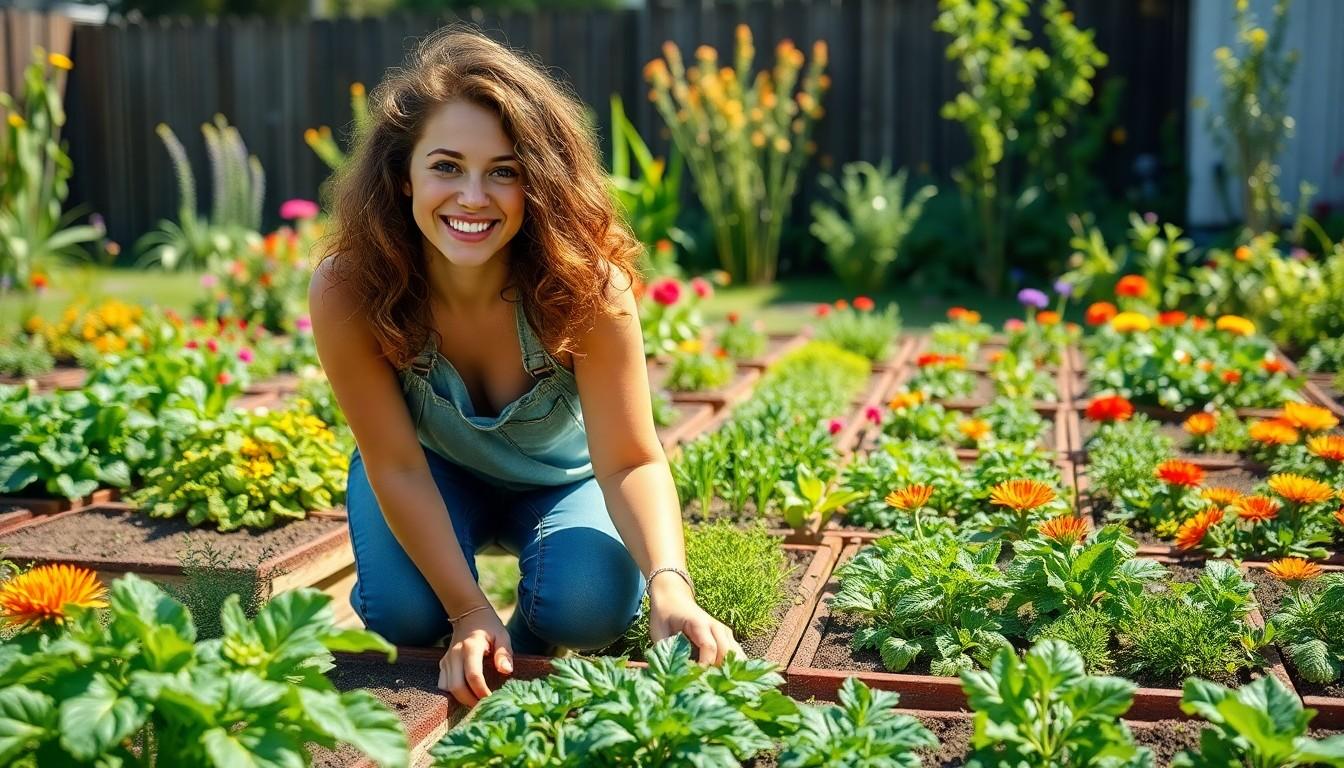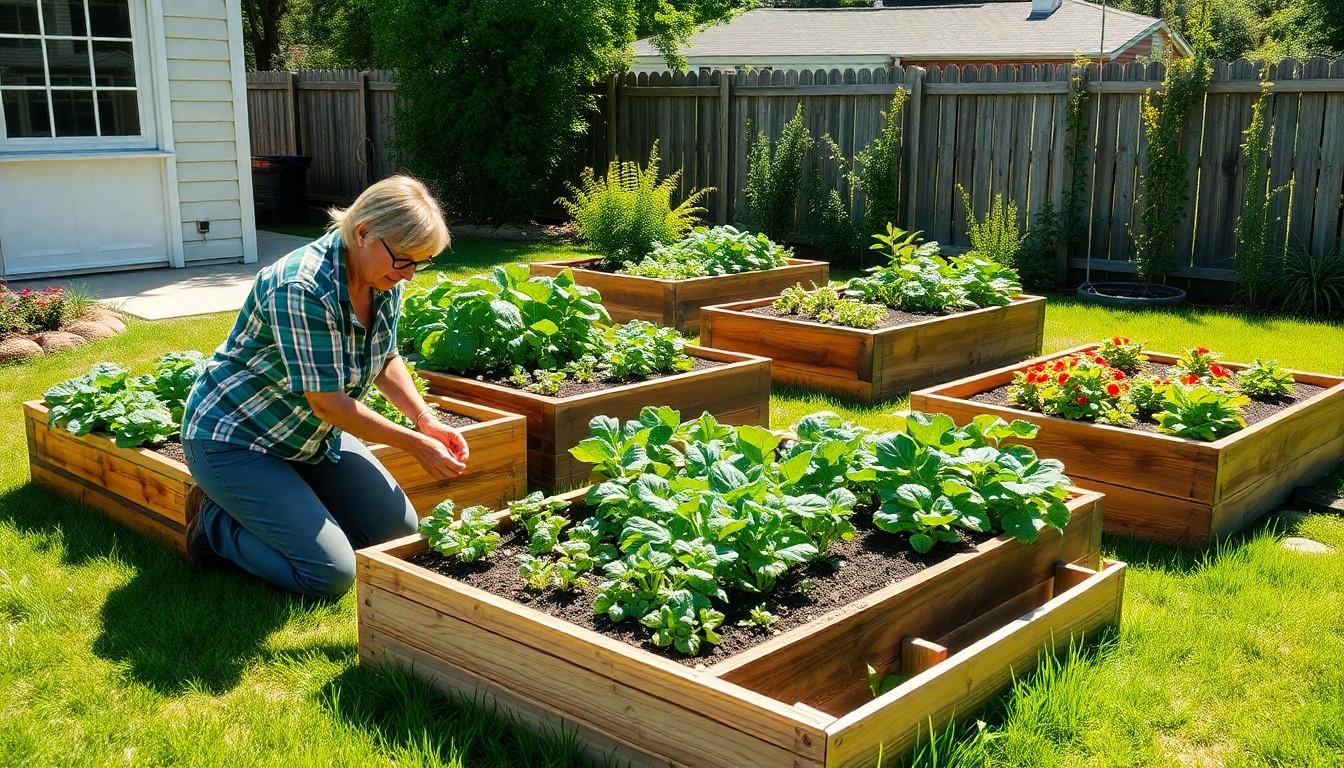Phone:
(701)814-6992
Physical address:
6296 Donnelly Plaza
Ratkeville, Bahamas.

Square foot gardening is the secret weapon every aspiring gardener needs. Imagine stepping into your backyard and transforming a small patch of earth into a vibrant vegetable paradise. With a little planning, even the most novice gardener can create a flourishing garden that would make any green thumb jealous.
Square foot gardening offers a practical solution for small-space gardening. This method enhances productivity while simplifying the planting process.
Square foot gardening encompasses a technique where a garden space is divided into square sections, typically measuring 1 foot by 1 foot. By organizing the garden in this manner, individuals maximize their planting area. Plants are placed closer together than in traditional gardening. This method allows for a diverse range of vegetables and herbs to thrive within a compact layout. Beginners often find this approach user-friendly, as it promotes thoughtful planning and easy maintenance.
Beginners enjoy multiple advantages from square foot gardening. Space efficiency stands out as a significant benefit. Small areas can effectively produce a variety of crops. A limited physical strain occurs due to the manageable height of raised beds. This technique minimizes weed growth, requiring less time for upkeep. Reduced water usage results from highly efficient planting methods. Additionally, beginners experience heightened crop yields by maximizing the growing potential in small spaces.

Effective planning creates a productive square foot garden. Organizing the garden layout ensures optimal use of space and resources.
Select materials conducive to square foot gardening. Common choices include untreated wood or composite for building raised beds. A sturdy mesh or grid helps define the square sections. Utilize quality soil blends that encourage healthy root growth. Incorporate organic fertilizers to enhance nutrient levels. Watering systems may include hoses or drip irrigation to ensure plants receive adequate moisture.
Identify a location that offers sufficient sunlight. Ideally, the garden site receives at least six to eight hours of direct sunlight daily. Avoid areas prone to flooding or excessive wind exposure. Proximity to water sources simplifies irrigation tasks. Position the garden near frequently used outdoor spaces to encourage maintenance and harvesting. Assess the soil drainage before planting to promote strong root development.
Several layout plans cater to various gardening needs and preferences. The most common designs provide straightforward options for beginners to optimize their small spaces effectively.
The traditional square foot layout divides garden beds into 1-foot squares. Each square features specific plants based on growth habits. For example, a square can hold a single tomato plant, while another may contain a group of radishes. This layout maximizes planting efficiency and allows gardeners to space out crops for better light and air circulation. Rotating plants each season ensures soil nutrients remain balanced. Beginners find this organized structure visually appealing and manageable.
Vertical square foot gardening brings an innovative approach to limited spaces. By using vertical elements like trellises, shelves, and wall planters, gardeners maximize vertical space for additional planting. Climbing plants such as beans and peas thrive in this setup, utilizing minimal ground area effectively. A vertical configuration enhances air circulation and sunlight exposure for all plants. Beginners can incorporate various plant types across levels to create a diverse growing environment. This method combines style and functionality, appealing to those new to gardening.
Successful square foot gardening hinges on thoughtful strategies and consistent care. By implementing well-researched practices, beginners can enjoy fruitful yields from limited spaces.
Companion planting enhances growth and pest management. Certain plants, like tomatoes and basil, thrive together by repelling harmful insects and improving flavor. Carrots and onions complement each other, with each masking the other’s scent from pests. Growing marigolds alongside vegetables deters nematodes and other detrimental insects. Understanding these relationships fosters a healthier ecosystem in the garden. Experimenting with combinations allows for tailored strategies to suit specific gardens.
Routine maintenance ensures a thriving garden. Regularly checking moisture levels keeps plants hydrated while preventing over-saturation. Pruning dead leaves improves air circulation and reduces disease risk. Fertilizing with organic materials, like compost or worm castings, nourishes plants and bolsters soil health. Monitoring for pests should occur weekly, allowing prompt intervention when necessary. Applying mulch suppresses weeds and retains soil moisture, simplifying care efforts. Investing time in maintenance leads to lush growth and plentiful harvests.
Embracing square foot gardening opens up a world of possibilities for beginners eager to cultivate their own vegetables and herbs. With its efficient layout and manageable approach, this method simplifies the gardening experience while maximizing yields.
By selecting the right materials and planning carefully, novice gardeners can create a vibrant and productive space. The incorporation of companion planting and routine maintenance further enhances the potential for success.
Ultimately, square foot gardening not only transforms small areas into flourishing gardens but also fosters a rewarding connection to nature. With a bit of dedication and creativity, anyone can enjoy the fruits of their labor in a compact and organized garden setting.